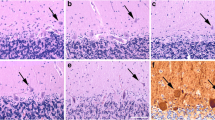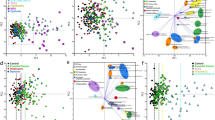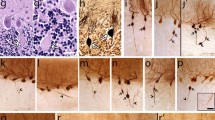Abstract
Postmortem studies have reported Purkinje cell loss in essential tremor (ET), and we recently demonstrated a significant increase in the mean distance between Purkinje cell bodies (i.e., a larger gap length distance) in ET cases vs. controls, likely reflecting a disease-associated reduction in Purkinje cells. We now analyze the regularity of distribution of Purkinje cells along the Purkinje cell layer to determine whether there is greater disorganization in ET cases than in age-matched controls. A standard parasagittal, formalin-fixed, tissue block was harvested from the neocerebellum of 50 ET cases and 25 age-matched controls. The gap length distance (μm) between Purkinje cells was quantified using a nearest neighbor analysis in which the distance between each Purkinje cell body was measured in OpenLAB software, version 5 (Improvision, Waltham, MA) by drawing a freehand line between adjacent Purkinje cell bodies along the entirety of the Purkinje cell layer within a given image. We analyzed the subject-specific variation in the organization of Purkinje cells along the Purkinje cell layer. The 50 ET cases and 25 controls were similar in age at death, gender, and brain weight. Overall, greater variation in gap length distance (i.e., more disorganization) was associated with greater gap length distance (p < 0.001) and younger age (p = 0.020). However, the variation in the Purkinje cell gap length distance (i.e., Purkinje cell organization) did not differ in ET cases and controls (p = 0.330). We observed that the regularity of the distribution of Purkinje cells along the Purkinje cell layer did not differ between ET cases and controls. Several alternative biological interpretations for this finding are discussed.

Similar content being viewed by others
References
Putzke JD, Whaley NR, Baba Y, Wszolek ZK, Uitti RJ. Essential tremor: predictors of disease progression in a clinical cohort. J Neurol Neurosurg Psychiatry. 2006;77:1235–7.
Louis ED, Agnew A, Gillman A, Gerbin M, Viner AS. Estimating annual rate of decline: prospective, longitudinal data on arm tremor severity in two groups of essential tremor cases. J Neurol Neurosurg Psychiatry. 2011;82:761–5.
Bares M, Husarova I, Lungu OV. Essential tremor, the cerebellum, and motor timing: towards integrating them into one complex entity. Tremor Other Hyperkinet Mov (N Y) 2012;2.
Grimaldi G, Manto M. Is essential tremor a Purkinjopathy? The role of the cerebellar cortex in its pathogenesis. Mov Disord. 2013;28:1759–61.
Passamonti L, Cerasa A, Quattrone A. Neuroimaging of essential tremor: what is the evidence for cerebellar involvement? Tremor Other Hyperkinet Mov (N Y) 2012;2.
Babij R, Lee M, Cortes E, Vonsattel JP, Faust PL, Louis ED. Purkinje cell axonal anatomy: quantifying morphometric changes in essential tremor versus control brains. Brain. 2013;136:3051–61.
Louis ED, Lee M, Babij R, Ma K, Cortes E, Vonsattel JP, et al. Reduced Purkinje cell dendritic arborization and loss of dendritic spines in essential tremor. Brain. 2014;137:3142–8.
Erickson-Davis CR, Faust PL, Vonsattel JP, Gupta S, Honig LS, Louis ED. “Hairy baskets” associated with degenerative Purkinje cell changes in essential tremor. J Neuropathol Exp Neurol. 2010;69:262–71.
Lin CY, Louis ED, Faust PL, Koeppen AH, Vonsattel JP, Kuo SH. Abnormal climbing fibre-Purkinje cell synaptic connections in the essential tremor cerebellum. Brain. 2014;137:3149–59.
Louis ED. Essential tremor: a common disorder of Purkinje neurons? Neuroscientist. 2015 Jun 4.
Louis ED, Faust PL, Vonsattel JP, Honig LS, Rajput A, Robinson CA, et al. Neuropathological changes in essential tremor: 33 cases compared with 21 controls. Brain. 2007;130:3297–307.
Louis ED, Babij R, Lee M, Cortes E, Vonsattel JP. Quantification of cerebellar hemispheric Purkinje cell linear density: 32 ET cases versus 16 controls. Mov Disord. 2013;28:1854–9.
Symanski C, Shill HA, Dugger B, Hentz JG, Adler CH, Jacobson SA, et al. Essential tremor is not associated with cerebellar Purkinje cell loss. Mov Disord. 2014;29:496–500.
Rajput AH, Robinson CA, Rajput ML, Robinson SL, Rajput A. Essential tremor is not dependent upon cerebellar Purkinje cell loss. Parkinsonism Relat Disord. 2012;18:626–8.
Jellinger KA. Is there cerebellar pathology in essential tremor? Mov Disord. 2014;29:435–6.
Louis ED, Faust PL, Vonsattel JP. Purkinje cell loss is a characteristic of essential tremor: towards a more mature understanding of pathogenesis. Parkinsonism Relat Disord. 2012;18:1003–4.
Louis ED, Kuo SH, Vonsattel JP, Faust PL. Torpedo formation and Purkinje cell loss: modeling their relationship in cerebellar disease. Cerebellum. 2014;14:433–9.
Choe M, Cortés E, Vonsattel JPG, Kuo SH, Faust PL, Louis ED. Purkinje cell loss in essential tremor: random sampling quantification and nearest neighbor analysis. Mov Disord. 2015;in press.
Hamling KR, Tobias ZJ, Weissman TA. Mapping the development of cerebellar Purkinje cells in zebrafish. Dev Neurobiol. 2015. doi:10.1002/dneu.22275.
Harasymiw JW, Bean P. Identification of heavy drinkers by using the early detection of alcohol consumption score. Alcohol Clin Exp Res. 2001;25:228–35.
Stoodley CJ, Schmahmann JD. Functional topography in the human cerebellum: a meta-analysis of neuroimaging studies. Neuroimage. 2009;44:489–501.
Louis ED, Faust PL, Ma KJ, Yu M, Cortes E, Vonsattel JPG. Torpedoes in the cerebellar vermis in essential tremor cases vs. controls. Cerebellum. 2011;10:812–9.
Hall TCMA, Corsellis JAN. Variations in the human Purkinje cell population according to age and sex. Neuropathol Appl Neurobiol. 1975;1:267–92.
Cerminara NL, Lang EJ, Sillitoe RV, Apps R. Redefining the cerebellar cortex as an assembly of non-uniform Purkinje cell microcircuits. Nat Rev Neurosci. 2015;16:79–93.
Acknowledgments
We thank the Harvard Brain Tissue Resource Center (supported in part by PHS grant number R24 MH068855) for providing the control tissue. We similarly thank the University of Kentucky Alzheimer’s Disease Center Biobank (P30 AG028383) for providing the control tissue, and the patients, staff, and clinicians who have contributed to their efforts.
Dr. Louis has received research support from the National Institutes of Health: NINDS #R01 NS042859 (principal investigator), NINDS #R01 NS086736 (principal investigator), NINDS #R01 NS085136 (principal investigator), and NINDS #R01 NS088257 (principal investigator). Dr. Kuo has received funding from International Essential Tremor Foundation: NINDS #K08 NS08738 (principal investigator), Louis V. Gerstner Jr. Scholar Award (principal investigator), Parkinson’s Disease Foundation (principal investigator), American Parkinson’s Disease Association (principal investigator), NIEHS pilot grant #ES009089 (principal investigator), NINDS #R01NS084948 (co-investigator), and NINDS #R01NS088257 (co-investigator). Dr. Faust has received funding from NINDS #R01 NS042859 (co-investigator), NINDS #R01 NS085136 (co-investigator), and NINDS #R01 NS088257 (co-investigator).
Authors’ Contributions
Each of the listed authors participated in both the conception and design of the study and in the data analysis and editing. All authors approved the final draft of the paper before it is submitted.
Author information
Authors and Affiliations
Corresponding author
Ethics declarations
Conflict of Interest
The authors declare that they have no competing interests.
Rights and permissions
About this article
Cite this article
Louis, E.D., Rabinowitz, D., Choe, M. et al. Mapping Purkinje Cell Placement Along the Purkinje Cell Layer: an Analysis of Postmortem Tissue from Essential Tremor Patients vs. Controls. Cerebellum 15, 726–731 (2016). https://doi.org/10.1007/s12311-015-0742-0
Published:
Issue Date:
DOI: https://doi.org/10.1007/s12311-015-0742-0




